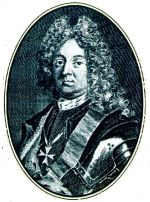In 1721, Bach presented a stylishly-bound set of six concertos in diverse combinations to the relatively minor Margrave of Brandenburg perhaps in the hope of gaining a position at the Margrave's court. If this was indeed their purpose, Bach failed; he was not hired. According to the manuscript, Bach's Fifth Brandenburg Concerto is scored for "one flute, one solo violin, one violin and one viola in the ensemble, cello and double-bass and harpsichord concertato."
What makes this concerto especially remarkable is the extended solo for the harpsichord. Although concertos for odd instruments were relatively common in the period, concertos for keyboard instruments were rare. At the time the harpsichord was known primarily as a continuo instrument and, as such, its role was to support the soloists, here the flute and violin. In this concerto Bach spotlights the harpsichord, making it a soloist as well. Indeed, the harpsichord seems to eclipse the genteel flute and violin, taking the first movement into increasingly remote harmonic areas, before beginning a lengthy cadenza (a virtuosic solo episode) of its own before the final ritornello. Bach's keyboard concertos would eventually lead to the modern piano concerto.

